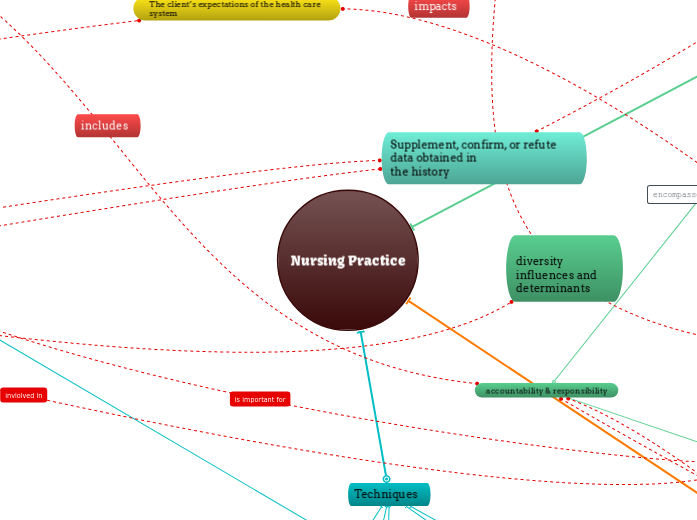Nursing Practice
Documentation
communication of clinical information
patient history
past
allergies
surgeries
injuries
prior hospitalizations
current
day of addmission
cheif complaint
Assessment
objective and subjective data
Planning
plan of care
Implementation
actions taken relevant to problem
Evaluation
evaluates patient response
influences
accountability & responsibility
for self & others
Techniques
Inspection
Observation
Vision, hearing, smell
Recognizes normal and abnormal
surfaces can be viewed
Palpation
uses hands
fingernails should be short
should be warm
tenderness, distension, masses
Tender areas are palpated last
distinguish
texture, temperature, and movement
light palpation
ends with deep
palpation
Ausculations
sounds
stethoscope
concentration and practice
normal sounds vs abnormal
frequency
loudness
quality
duration
Percussion
sound
fingertips to produce a vibration
location
size
density
percussion notes
techniques
indirect
direct
Olfaction
odours
Alcohol
urine
body odour
feces
Professionalism
respectful relationships
honest relationships
professional approach
ethics
values
should and should not do
dilemma
conflict
is the
Therapeutic Relationship
the person
Self knowledge
development
recognize own experience is shaped by several factors
Race
Nationality
Culture
Health
socio economic conditions
gender
education
Early childhood experience
accomplishments
beliefs
to act purposefully
Empathy
attend to the subjective experience
Validate that his/her understanding of the client’s experience
Self Awareness
Subjective thoughts, feelings, actions
Knowledge of person
health/illness
biological, psychological and/or socio-contextual
symptoms
Standard interventions and issues of rehabilitation
Knowledge of best practices
influences
on health care and
health care policy
Awareness
of boundaries
& limits of
professional role
Reflection
client’s best interest
recognize boundary violations
having special clients
spending extra time with clients
keeping secrets with clients
The client’s expectations of the health care system
How the health care professional functions
Changes in the health care system such as accessibility, resources, etc
Health Assessment
physical assessment
Gather baseline data
Confirm and identify nursing diagnoses
signs
What you see
Obseved by others
Symtoms
How it feels
sensation or emotion
not observable to others
perceived or experienced
by the patient
General Survey
Physical appearance
age
Level of conscieness
sexual development
skin colour
facial expressions
Body structure
stature
symmetry
Mobility
gait
walking
range of motion
Behaviour
facial expression
mood
speech
dress
personal hygiene
Measurements
weight
height
BMI
Arm span
Waist to hip ratio
changing health status, management
Range of motion
Vital signs
Activities of daily living
bathing
toileting
dressing
components
Subjective
Pain levels
experience
Objective
Measurements
